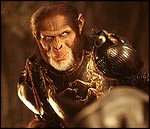
Hollywood’s motto could easily be “monkey see, monkey remake,” despite the fact that remakes are always far worse than the original. Next to remakes in usefulness are the sequels; the deservedly successful Planet of the Apes (1968) was followed by four of them, plus a TV series and a cartoon series – all, needless to say, vastly inferior. But we are dealing here with the particularly dense producer- and filmmaker-apes, who, unlike those in the movie, do not assert their superiority to humans but sink, crowd-pleasingly, to their level.
Why was the original Planet of the Apes so appealing? Because we are fascinated with those creatures genetically closest to us, titillated by the idea of their emulating us – even overtaking us in some ways – but not eventually supplanting us. It was, despite abundant monkeyshines, still human enough. In Tim Burton’s new version, the accent is on technology. Space-station and space-capsule technology; gimmick, gadget, and gizmo technology. And also on the new filmmaking technology: Everything is bigger, fancier, more digitally magnified and multiplied. Charlton Heston and his pals were pursued by only a modest complement of apes, who did not even have suits of armor. Now enormous simian and human armies clash by night and day, till surfeit sets in well before picture’s end.
True, the 1968 screenplay had some labored jokes, but at least they were original. The new screenplay, by William Broyles Jr. with Lawrence Konner and Mark Rosenthal, has very little humor and gets its few laughs from comic twists on some of the original’s dialogue and situations. Indeed, the funniest bit is the reappearance of Heston in a simian cameo, allowing him the same last line as in 1968. (Then, of course, it had tragic impact; here, it is merely parodic.) And in 1968 there were no such silly sequences as that of the hero and his friends escaping through a variety of ape abodes and farcically interrupting various goings-on within.
Where Heston had heroic virility, Mark Wahlberg, the new hero, capitalizes on his boyishness. Further, Heston had a genuinely moving, loving friendship with the chimpanzee scientist superbly played by Kim Hunter, which, despite Helena Bonham Carter’s valiant effort, the present film cannot duplicate. And Heston also had an evolving and involving relationship with Nova (the beautiful Linda Harrison, eloquent even in a nonspeaking part); Wahlberg has nothing of interest going with Daena, her counterpart here, whom the very ordinary Estella Warren, for all her lines and heroics, cannot endear to us.
What does Burton offer beyond technology? There is striking cinematography by Philippe Rousselot, and elaborate ape makeup by Rick Baker (though the 57 varieties of simian physiognomy are less winning than the fewer, simpler monkey faces that John Chambers created for the original). There are a few fine performances, notably Tim Roth as the evil Thade, who snarls and moves with exquisite menace, and Michael Clarke Duncan as his imposingly powerful lieutenant. While he is no substitute for Roddy McDowall, Paul Giamatti manages at times to outwit his rather witless role, and Bonham Carter’s sweet face is allowed to peek demurely through her cavalierly light chimp makeup. There are also some impressive gymnastics from the spectacularly leaping or ferociously, four-footedly loping apes.
The new Planet is devoured by its own mechanical ostentation, generates no emotional involvement, and has a smart-ass, infinitely less powerful ending than the original. It leaves some characters in a state of unresolved limbo, hinting at a possible sequel, from which may heaven preserve us. Burton wanted performances that were “20 percent ape and 80 percent human.” It remains to be seen whether there are enough moviegoers in whom those figures are reversed to make this remake a hit.
Peter Rainer is on a brief leave.
Planet of the Apes
Directed by Tim Burton; starring Mark Wahlberg, Tim Roth, and Helena Bonham Carter.